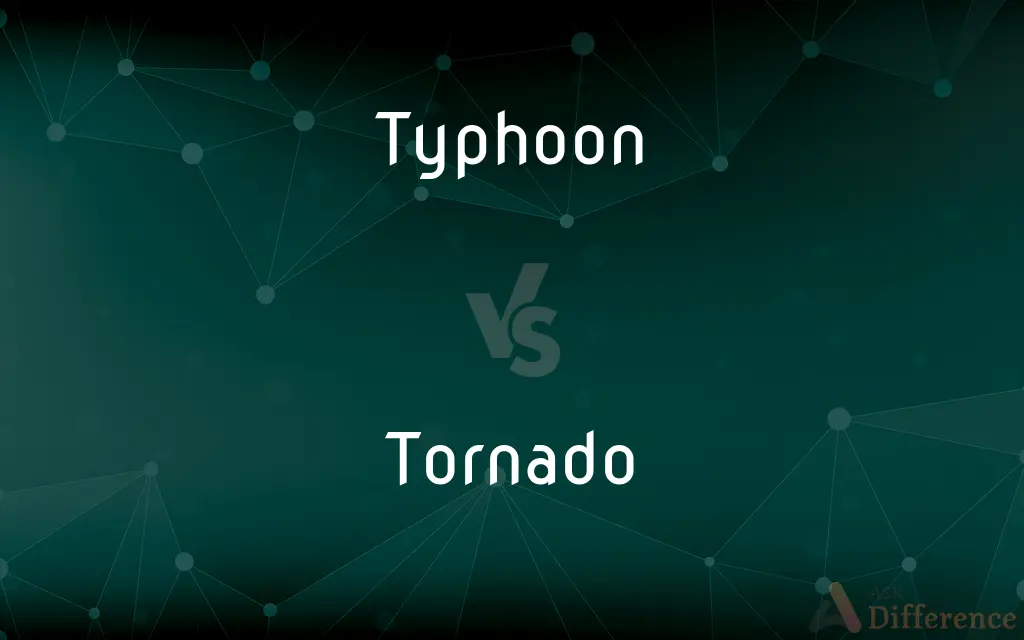Typhoon vs. Tornado — What's the Difference?
Edited by Tayyaba Rehman — By Fiza Rafique — Updated on April 30, 2024
Typhoons are large-scale storm systems that form over warm ocean waters and can impact large areas, while tornadoes are smaller, intense columns of spinning air that form over land and cause localized damage.

Difference Between Typhoon and Tornado
Table of Contents
ADVERTISEMENT
Key Differences
Typhoons, known regionally as hurricanes or cyclones depending on their location, are massive storm systems originating over warm ocean waters, primarily in tropical or subtropical areas. In contrast, tornadoes are highly localized whirlwinds that form under severe thunderstorms, primarily over land.
The scale and duration of typhoons are significantly larger and longer than tornadoes. A typhoon can last for days or weeks, affecting vast regions and multiple countries, while tornadoes typically last for a few minutes to over an hour and affect much smaller geographic areas.
Typhoons derive their energy from the warm waters of the ocean and lose strength as they move over land or cooler waters. On the other hand, tornadoes are powered by severe thunderstorms and can form rapidly, depending on atmospheric conditions.
In terms of damage, typhoons can cause widespread devastation through high winds, heavy rain, and storm surges, potentially leading to flooding and long-term impacts on the affected areas. Conversely, tornadoes, although more localized, can cause extreme destruction along their path, including uprooting trees, destroying buildings, and hurling debris at high speeds.
The wind speeds in tornadoes can be higher than those in typhoons. Tornado winds can exceed 300 miles per hour, the highest category on the Enhanced Fujita scale, whereas typhoon winds can exceed 150 miles per hour, the highest category on the Saffir-Simpson Hurricane Wind Scale.
ADVERTISEMENT
Comparison Chart
Formation
Over warm ocean waters
Over land under severe thunderstorms
Size and Area
Large-scale, affecting multiple countries
Localized, affecting small areas
Duration
Days to weeks
Minutes to over an hour
Energy Source
Warm ocean waters
Severe thunderstorms
Typical Damage
Widespread: wind, rain, floods
Localized but intense: high winds, debris
Compare with Definitions
Typhoon
A tropical storm in the region of the Indian or western Pacific oceans.
The typhoon caused major flooding in coastal areas.
Tornado
Can cause extreme destruction in its direct path.
The tornado’s path was evident from the swath of destruction it left.
Typhoon
Often tracked by meteorological organizations.
The weather agency has been tracking the typhoon for several days.
Tornado
Typically occurs during severe weather conditions.
Tornado warnings were issued as the storm intensified.
Typhoon
Can lead to significant humanitarian crises.
The aftermath of the typhoon left thousands in need of aid.
Tornado
A mobile, destructive vortex of violently rotating winds.
The tornado ripped through the town, destroying homes.
Typhoon
Characterized by high winds and heavy rains.
The typhoon’s winds reached speeds of over 100 miles per hour.
Tornado
Often appears suddenly and with little warning.
The tornado formed so quickly that many were caught unprepared.
Typhoon
Causes large-scale evacuations and preparations.
Residents were evacuated as the typhoon approached.
Tornado
Measured on the Enhanced Fujita scale.
The tornado was classified as an EF3, with winds of up to 165 miles per hour.
Typhoon
A typhoon is a mature tropical cyclone that develops between 180° and 100°E in the Northern Hemisphere. This region is referred to as the Northwestern Pacific Basin, and is the most active tropical cyclone basin on Earth, accounting for almost one-third of the world's annual tropical cyclones.
Tornado
A tornado is a violently rotating column of air that is in contact with both the surface of the Earth and a cumulonimbus cloud or, in rare cases, the base of a cumulus cloud. The windstorm is often referred to as a twister, whirlwind or cyclone, although the word cyclone is used in meteorology to name a weather system with a low-pressure area in the center around which, from an observer looking down toward the surface of the earth, winds blow counterclockwise in the Northern Hemisphere and clockwise in the Southern.
Typhoon
A tropical cyclone occurring in the western Pacific or Indian Oceans.
Tornado
A violently rotating column of air extending from a cumulonimbus cloud to the ground, ranging in width from a few meters to more than a kilometer, with destructive winds up to 510 kilometers (316 miles) per hour or higher. Tornadoes are typically associated with a funnel cloud pendant from a storm's wall cloud, often extending to the bottom of the tornado.
Typhoon
A weather phenomenon in the northwestern Pacific that is precisely equivalent to a hurricane, which results in wind speeds of 64 knots (118 km/h) or above. Equivalent to a cyclone in the Indian Ocean and Indonesia/Australia.
Tornado
A violent thunderstorm in western Africa or nearby Atlantic waters.
Typhoon
(intransitive) To swirl like a hurricane.
Tornado
A whirlwind or hurricane.
Typhoon
A violent whirlwind; specifically, a violent whirlwind occurring in the Chinese seas.
Tornado
(meteorology) A violent windstorm characterized by a mobile, twisting, funnel-shaped cloud.
A tornado is a rotating column of air.
Typhoon
A tropical cyclone occurring in the western Pacific or Indian oceans
Tornado
A violent whirling wind; specifically (Meteorol.), a tempest distinguished by a rapid whirling and slow progressive motion, usually accompaned with severe thunder, lightning, and torrents of rain, and commonly of short duration and small breadth; a small cyclone.
Tornado
A localized and violently destructive windstorm occurring over land characterized by a funnel-shaped cloud extending toward the ground
Tornado
A purified and potent form of cocaine that is smoked rather than snorted
Common Curiosities
Are there different types of tornadoes?
Yes, tornadoes can vary from weak (causing light damage) to incredibly powerful (capable of devastating destruction).
How can you tell if a tornado is likely to occur?
Signs include a dark, often greenish sky, a wall cloud, large hail, and a loud roar similar to a freight train.
What should you do if you're in a car during a tornado?
If possible, drive at a right angle to the storm's path. If not safe to drive, park the car as quickly and safely as possible and seek shelter in a sturdy building.
How are tornadoes rated?
Tornadoes are rated according to the Enhanced Fujita scale, which assesses damage to estimate wind speeds.
What is a tornado watch versus a tornado warning?
A tornado watch means conditions are favorable for tornadoes to form; a warning means one has been sighted or indicated by radar.
Can tornadoes occur at night?
Yes, tornadoes can occur at any time, including at night, making them more dangerous as they are harder to see.
What are some long-term effects of tornadoes on communities?
Long-term effects include physical reconstruction, psychological impacts on residents, and economic disruptions.
What steps can individuals take to mitigate tornado damage?
Individuals can reinforce their homes, have a safe room or area, and keep an emergency kit ready.
How can communities prepare for a typhoon?
Communities prepare through building resilient infrastructure, having evacuation plans in place, and ensuring timely dissemination of meteorological information.
What is the role of sea surface temperature in the formation of typhoons?
Warmer sea surface temperatures provide the energy needed for typhoons to develop and sustain their strength.
What meteorological conditions are conducive to tornado formation?
Conditions include a combination of warm, moist air near the ground with cooler air above, and significant wind shear.
How do typhoons get their names?
Typhoons are named from a pre-determined list to simplify communications and avoid confusion during warnings.
What regions are most affected by typhoons?
Typhoons primarily affect areas in the Western Pacific, including countries like Japan, China, the Philippines, and Taiwan.
What is the difference between a typhoon and a hurricane?
The difference is mainly regional; both are tropical cyclones, but they are called hurricanes in the Atlantic and Northeast Pacific, and typhoons in the Northwest Pacific.
How do meteorologists forecast tornadoes?
They use weather radar, satellite, and other data to monitor storm development and predict potential tornado formation.
Share Your Discovery

Previous Comparison
Reading vs. Writing
Next Comparison
Audit vs. SurveyAuthor Spotlight
Written by
Fiza RafiqueFiza Rafique is a skilled content writer at AskDifference.com, where she meticulously refines and enhances written pieces. Drawing from her vast editorial expertise, Fiza ensures clarity, accuracy, and precision in every article. Passionate about language, she continually seeks to elevate the quality of content for readers worldwide.
Edited by
Tayyaba RehmanTayyaba Rehman is a distinguished writer, currently serving as a primary contributor to askdifference.com. As a researcher in semantics and etymology, Tayyaba's passion for the complexity of languages and their distinctions has found a perfect home on the platform. Tayyaba delves into the intricacies of language, distinguishing between commonly confused words and phrases, thereby providing clarity for readers worldwide.
















































